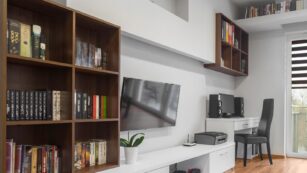
Mediterranean architecture and house plans draw inspiration from countries in Southern Europe around the Mediterranean Sea, such as Italy, Portugal, Spain etc. Eminent architects like Addison Mizner, Bertram Goodhue, Paul Williams, and Sumner Spaulding popularized the Mediterranean style of architecture in the United States. Mediterranean style homes became extremely popular in the 20th century and have captivated homebuyers for decades. . These homes are mirrored after the villas found in seaside Mediterranean towns, with red roof tiles, stucco exteriors, and a focus on indoor-outdoor living.
Here are some of the key features of Mediterranean House Plans:
Red Tiled Roofs
Conventionally, house roof designs in the Mediterranean style of architecture focus on symmetry, low pitched slopes, broad overhanging eaves, and heavy red tiles. These elements keep homes cool and breezy during hot temperatures, promoting the easy and slow lifestyles found in the seaside towns during the Renaissance.
Stucco Walls
The exterior of a Mediterranean house is typically created with white stucco, offering a smooth textured finish. The other benefit of Stucco is insulation. A stucco finish protects exterior wall surfaces from extreme weather like harsh sunlight, UV rays, rains etc that are typical of Mediterranean climates. Stucco can also be molded into decorative shapes such as niches, arches, or moldings.
Outdoor living
The Mediterranean lifestyle is all about a blend of indoor and outdoor living. Homes feature outdoor living spaces like courtyards and patios for owners to enjoy the beautiful climate or entertain their friends and family.
Arches
Mediterranean architecture features arched doorways and windows, adding a touch of splendor and old-world charm to the home.
Iron details
One of the other defining characteristics of Mediterranean homes is intricate wrought iron details in balconies, railings, grilles etc.
Natural Materials
Mediterranean homes have an unmistakable connection with nature which is also seen in their use of natural building materials like stone, wood, terracotta, etc creating a sense of connection with nature.
Some Popular Mediterranean House Plan Styles
Let’s take a closer look at some of the most popular Mediterranean floor plans and what distinguishes them from the rest:
Spanish Colonial
Spanish Colonial architecture also known as Mediterranean revival architecture was inspired by Spanish missions and Mediterranean style homes. The key feature was that the house was designed to keep the interiors cool. The other elements include red-tiled roofs, arches, exposed beams, wrought iron work, and colorful tiles. These homes also include courtyard and patios to promote a connection with the outdoors.
Moorish style homes
These homes are influenced by the Moorish style of architecture which features design elements like horseshoe arches, tilework, and decorative plasterwork. These homes are influenced by the architecture of the Moors, who ruled parts of Spain, North Africa, and the Middle East and have a fusion of Islamic, Arabic, and Spanish design elements. As a result, the homes look quite exotic, intricate and visually striking. An interesting feature of this style is the use of Ornamental Tilework (Zellij).
Italian Renaissance
This style is marked by the classical influence of Italy during the Renaissance area and is distinguished by symmetry and grandeur. The homes are known for their grand scale, symmetrical design and ornate interiors. In addition to columns and pilasters, you will also find details like beautiful stonework, pediments, friezes and cornices in the home giving it a stately and grand appearance.
Modern Mediterranean
A large number of contemporary Mediterranean homes have the modern-style. These house plans take the traditional elements of Mediterranean design and blend them with modern lifestyle and comforts. So, you will find classic features like stucco walls, red terracotta roofs, and arches but also open layouts, glass doors, large windows, and gourmet kitchens. Sleek lines and clean finishes give an updated look to the Mediterranean architecture style while still retaining its essence. Outdoor spaces often have modern amenities like infinity pools, outdoor kitchens, and lounges.
Greek Revival homes
Greek-style Revival homes take inspiration from the ancient temples of Greece. They can be recognized from their symmetrical facades, columns, and gabled roofs. The exterior is white or light and the columns are typically Doric, Ionic, or Corinthian. Another defining characteristic is the use of large windows, high ceilings and roomy interiors that add to the sense of grandeur. Greek Revival homes also include beautiful exteriors including verandas, pergolas, and landscaped gardens.
French Country Mediterranean homes
This style blends the beauty of French countryside and Mediterranean architecture to create a relaxed but refined atmosphere. The exterior features steeply pitched roofs, stone or brick exteriors, large front porches while the interiors are elegant with exposed beams, quaint fireplaces, and a mix of antique and contemporary furnishings. Gardens, courtyards, and outdoor meal areas are an important aspect of these homes, offering a natural setting to enjoy family life.
Mission style homes
As the name suggests, this architecture follows the Spanish missions built during the 18th and 19th centuries with a simple and charming design. The houses feature stucco walls, red tiled roofs, arched corridors with roomy interiors, simple decor and an emphasis on natural light. Again, outdoor spaces are very important in the mission-style homes with courtyards, patios, and gardens included in the floor plan.
How to choose the right Mediterranean House Plan?
Consider the overall landscape and weather conditions of your region. Your lifestyle, budget, and desired degree of personalization all play an important role in making the right choice. Whether you want a traditional mission style home or a modern Mediterranean villa, you will find a wide range of choices to suit your needs and preferences.
Conclusion
Mediterranean homes are known for their classic appeal and everlasting beauty. Apart from their aesthetic beauty, they are energy efficient and sustainable in the long run due to the stucco exterior and terracotta tile roofs. The emphasis on outdoor living in Mediterranean house design means that you get ample opportunities for entertaining and relaxation. If you are thinking in terms of resale value, then Mediterranean homes command a premium price in the real estate market due to their timeless appeal.














